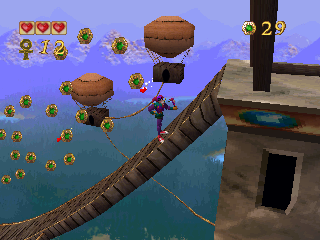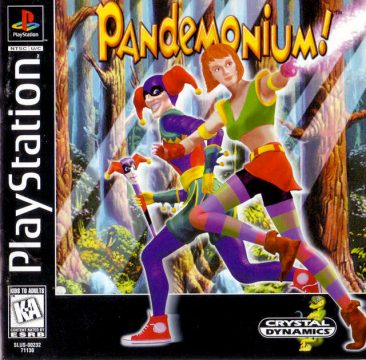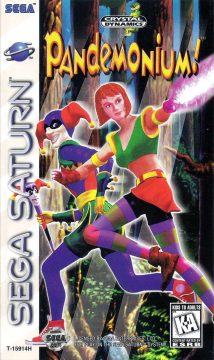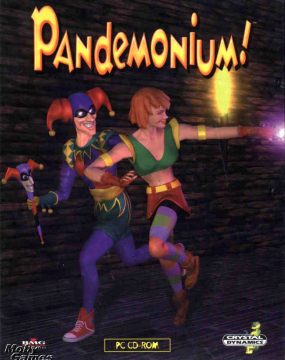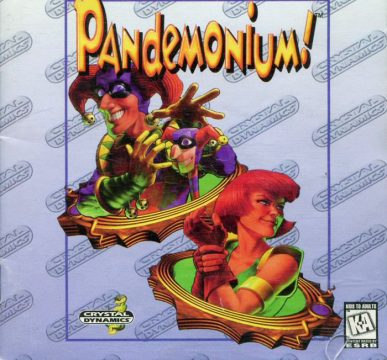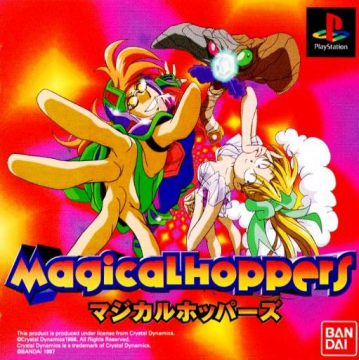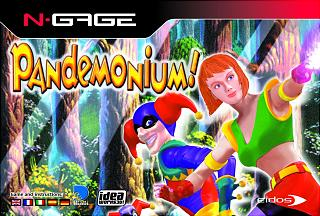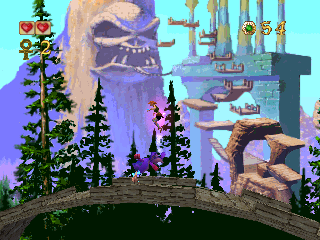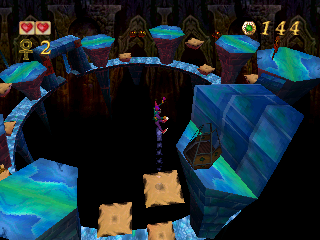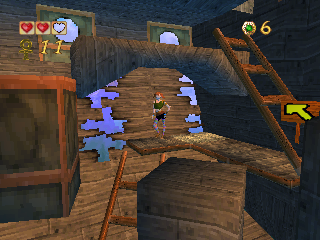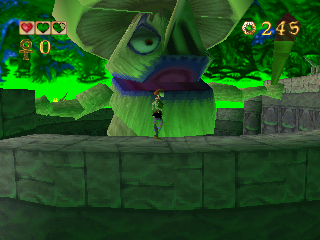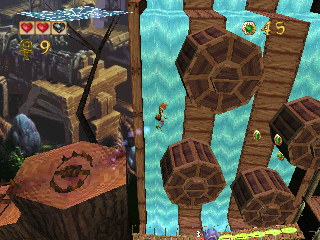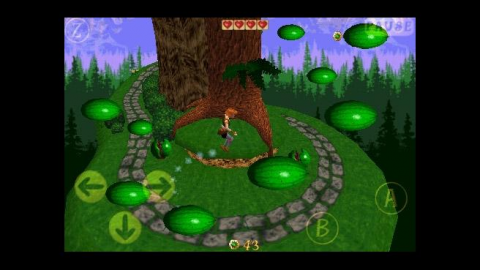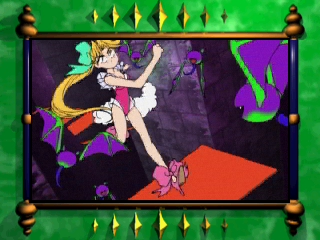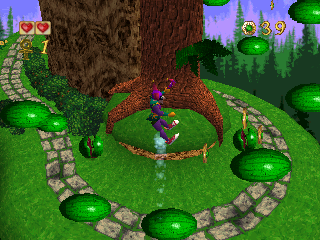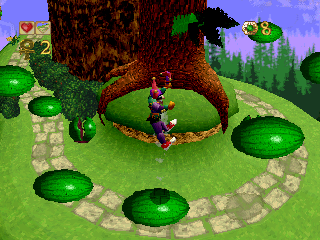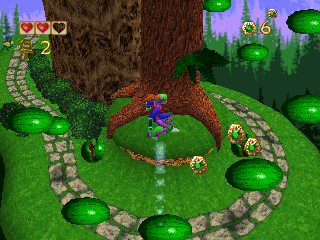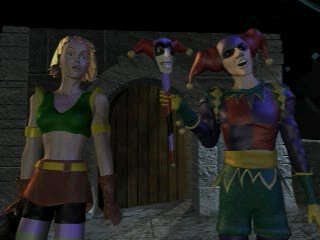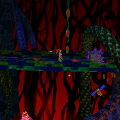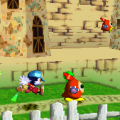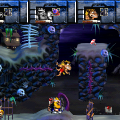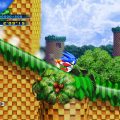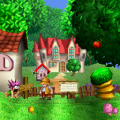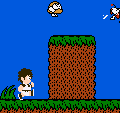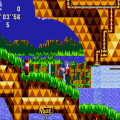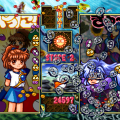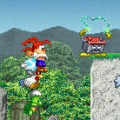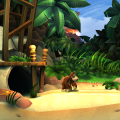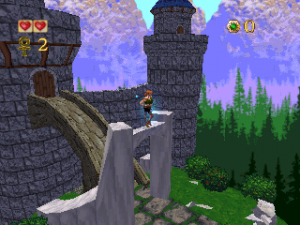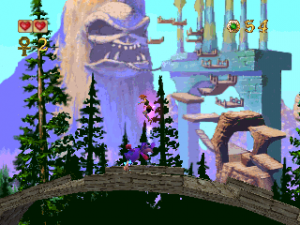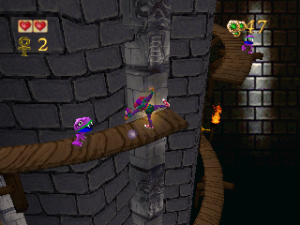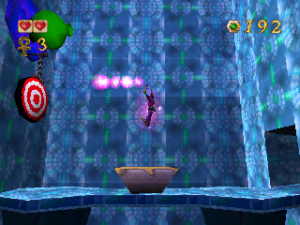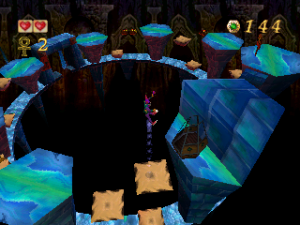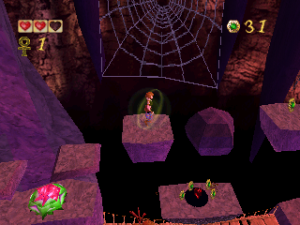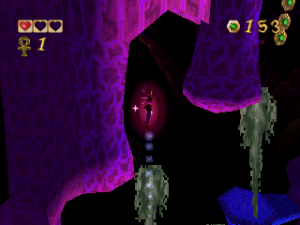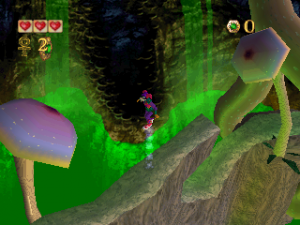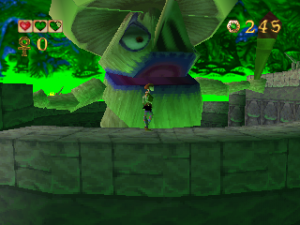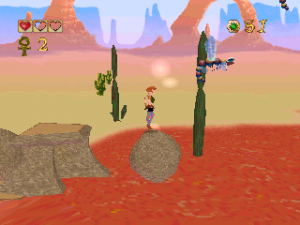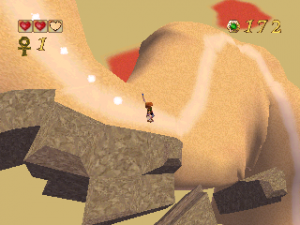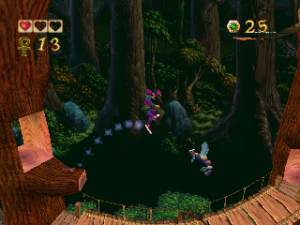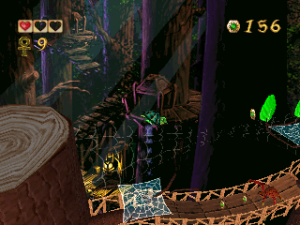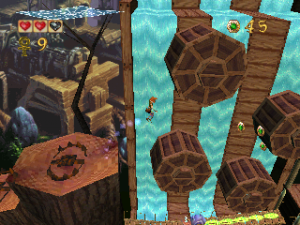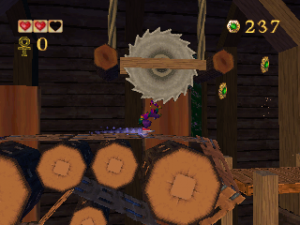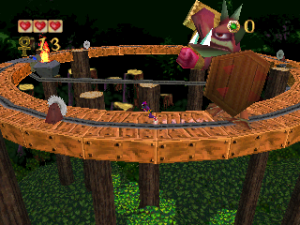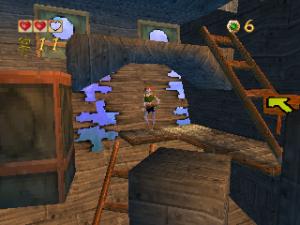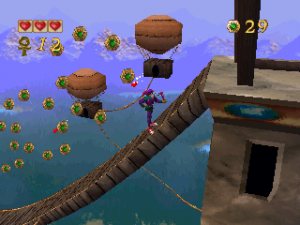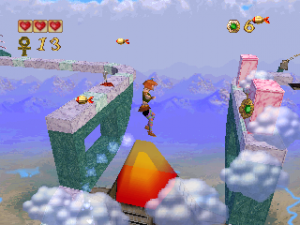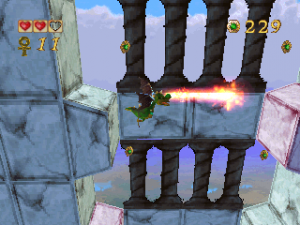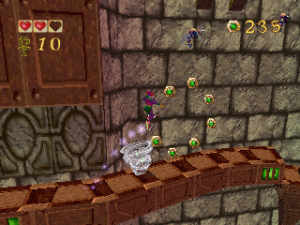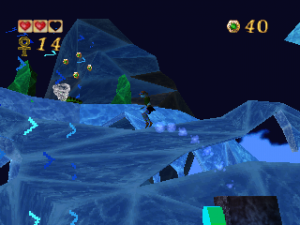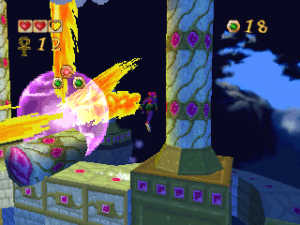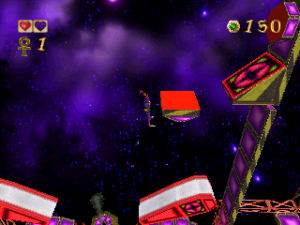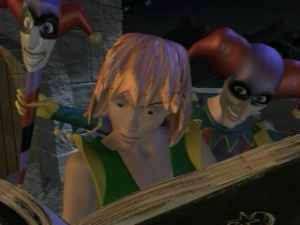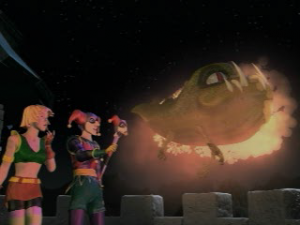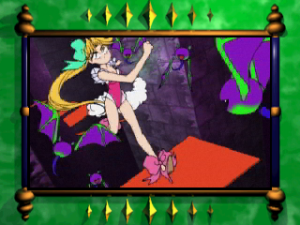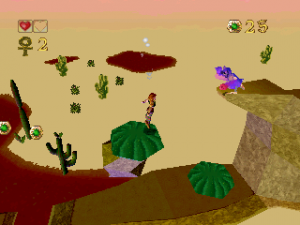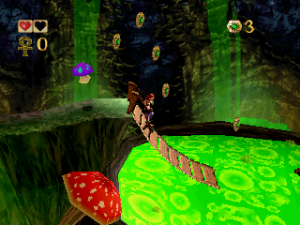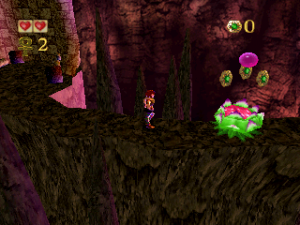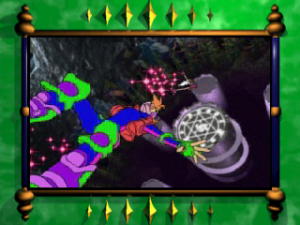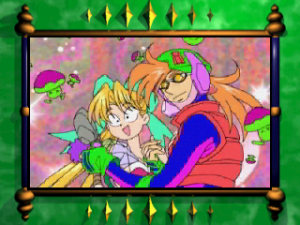- Pandemonium!
- Pandemonium 2
By the mid-90s, the Golden Age of 2D was about to meet its demise. As Nintendo, Sega, and the new kid on the video game block Sony debuted their new 32/64-bit consoles and 3D graphic accelerator cards became available to PCs, the push for polygons and the Z-axis went into full swing. 1996 was watershed year for gaming, giving the world the classics Super Mario 64, NiGHTS…Into Dreams, Crash Bandicoot, and Quake. Suddenly, Toy Story became the benchmark to gauge graphical prowess and anything 2D (or at least not prerendered CGI-looking) was now SOOOO last decade.
However, until everyone followed the path Nintendo made with its 3D Mario, developers were still unsure the best means to use their new dimension, creating many evolutionary dead-ends for 3D movement like in Bug!. Thus, the term “2.5D” was spawned for the middle-ground of mostly 2D gameplay in a 3D environment, a term that’d be later watered down to include the likes of Street Fighter IV and the New Super Mario Bros. series, despite no use of the Z-axis whatsoever. This brief period of transitional gaming was rarely used to its full potential — at least a nice balance of 2D and 3D in one package — with the Klonoa games being the most acclaimed and best remembered of true 2.5D. But Namco’s mascot platformer wasn’t the first to this one-half of a dimension, as it was beat to the punch by the first Pandemonium!.
Now, Crystal Dynamics is a company that can only be born of the 90s. Most of their lineup of IPs scream the grunge adolescent ‘tude wanting to stick it to the establishment that speaks to the 12 year old male inside of us with Tomb Raider, Legacy of Kain, Gex, and more. Pandemonium!, at least with the first game, had that family-friendly Shrek-level of snark akin to the company’s reptilian platformer (with less pop cultural references). After all, their other published titles for the 1996 season were for the Teen and Mature rated crowd, so a game safe for the kiddies ready before Christmas is good for business, and with a few thousand polygons to move in a new dimension, what better way to test the waters but with some hop and boppers too cool for even Sonic? A platformer for the future disaffected slacker teenager starring, what else? Disaffected slacker teenagers. Though like the dark age of comics during the 90s, the push for image consciousness meant a later drastic mood shift would come in short order, causing a stark change in tone between the two titles merely less than one year apart from each other.
The Pandemonium franchise lost steam fairly quickly. The push for full 3D movement was already in full swing even with the release of the first title, and better 2.5D games like Klonoa outclassed the series critically. The issue was that there was a spark there for a kid-friendly fun romp from the company that could’ve been polished up, but instead sought that crowded older crowd cash that led it into minor obscurity. Pandemonium 1 & 2 serve as time capsules and a bit of a warning about building success between platforming dimensions and how-tos for characterizations. Fortunately, its current publisher Square Enix makes both readily available and cheap to acquire, so experiencing this rather okay duet isn’t a hard bargain.
The world of Pandemonium! is referred to as Lyr, a realm cobbled from multiple standard Renaissance Faire-grade fantasy of dragons and castles and magic abound. Even our plucky hero duo sport attire that look like they were cribbed from a low-rent Shakespeare Halloween costume shop. Fargus is an unfunny off-kilter jester voiced by actual funny comedian Greg Proops. He carries with him a sentient similar-looking stick-puppet Sid at all times, talking with a butch voice and spouting catchphrase-level quips. Nikki is an acrobatic, part of the Flying Fleugel Family, and is voiced by commercial and home shopping spokesperson Helen Rosenthal. Though she’s great at tricks, her daydreams generally lead to trouble within the carnival she travels with. All three wish for more to their lives, Nikki especially wanting to become a sorceress. However, their goals are less than scrupulous (Fargus & Sid seem to be in it just to “make some boom-booms”), and mischief can only follow in short order.
Much of the backstory to the plot is left only in a spiel written within the instruction manual. Suffice to say, the two slacker ne’er-do-wells (and stick-puppet) meet up at a wizard training seminar in a castle, grow bored from the tacky sorcerer Tony “The Worldy One” Vu’s lecture, only to follow and snatch the discarded spellbook after their magic professor drops it during his drunken stupor. The starting FMV begins with the trio up on one of the castle’s balconys toying with simple pyrotechnic spells in the sky. Fargus and Sid pressure Nikki to try out a 10th Level Spell, only to conjuer up a monster name Yungo who proceeds to gobble up their nearby home village. The only way to stop Yungo and bring back the village is to wish it away. Good thing the spellbook has a map to a Wishing Engine.
Reaching the Wishing Engine proves quite the task. Five themed areas split amongst 18 levels separates the trio from their trouble-fixing wish. Many of the stages follow typical kid-friendly platforming venues of grasslands, dark caverns, deserts, forests, castles, and cloudtop skies. While not the most original themes, the game generally makes up for it with vivid array of color splashed onscreen, even with many backdrops being dark or nearly black. The use of colored lighting is a detail that wasn’t widespread among similar 3D/2.5D platformers of the era, so the mood of the somewhat boilerplate stage ideas is heightened. Not that the game tries to take itself seriously. The standard foe stomps around going “Duhh! Duhh!” like morons and levels are littered with plenty of peculiar makeshift trampolines for the acrobatic leapers to bounce off of, including spider webs and watermelons. It’s not as silly as Crash Bandicoot’s outings, but there is more than a twinge of jest in the world of Lyr. The musical score itself plays with fantastical whimsy. It’s nothing overtly notable, but the stage select tune is very hummable.
The design layouts are fairly standard to other 2.5 ilk. The path traversed is roughly a linear 2D track that bends, rolls, corkscrews, and generally wraps in a 3D environment. It’s not often that the pathway splits or overlaps in any way, so progress is simple enough to traverse by heading left or right. This leaves the camera to serve as an overseeing spectator that usually stays linked to the player while tilting up or down zooming in or out, or leaning behind or in front to bring a cinematic twinge to flatter areas of the stage, rarely locking in place for long. In essence, the motion of the 3D and camera is closer to NiGHTS…Into Dreams than Klonoa in this respect. However, this play with the view gets a little too ambitious, leading to moments of focusing more on the player in a close-up and not enough to warn of an enemy just out of frame, leading to some cheap hits.
The challenge becomes very touch-and-go. As a platformer, most of the hazard lies in the level itself, dodging buzzsaws and lightning and spikes while not falling into bottomless pits of hot patches of sand. Most of the enemies merely march along ledges ready to be stepped on Mario-style, though the flaky camera angles can cause you to be blindsided or misjudge a jump, and with only two hearts at the start, a sudden lose of life can be just around a bend. Hopping on enemies is the main attack as only Fargus has a secondary attack. His special move is a cartwheel, though it only has a short-range and leaves him vulnerable afterwards as he rights himself. Nikki’s specialty lies in her double-jump, which is leagues more helpful for the majority of the game, though launching into the 2nd jump takes great timing within the arc of the first leap in order to be performed, which can lead to a costly fall if you try to use that double jump as a crutch.
Luckily, there are powerups scattered within the stages. The best is the temporary invincibility, obviously, giving the player a simple silver texture. The other 3 are various magic blasts: red fireballs, blue freeze rays, and green shrink rays. The fireballs outclasses the other two, as freezing or shrinking enemies still requires a stomp on them to kill them outright and the spell only lasts so long. Sadly, one blow from a foe or stage hazard causes Fargus or Nikki to lose their magic blast. Rounding out the collectibles are Ankhs for lives, gem-encrusted coins to collect (300 for one added life; not the usual 100). Nabbing a high enough percentage of coinage earns a minigame at the end of the level to collect more treasure: an obstacle course while being chased by a vortex, or a giant pinball machine where Nikki or Fargas play the ball. Finally, nestled hidden in some stages are gold-rimmed hearts that’ll permanently add to the paltry sum of 2 the player starts off with, adding up to 7 in total.
The most unique use of magic in the game comes from shapechanging barries the slackers will pass through. Running inbetween these areas shifts the player of choice into an animal until they pass through the next gate, with each form having its own power. The frog hops high amongst platforms, the turtle can hide in its shell for protection, the rhino barrels through enemies with ease, but the most fun segments involve transforming into a little red dragon to fly and breathe fire. Each of these sections are built to work each skill to their advantages and serve as nice changes of pace from the usual hop & bop.
Lightly interspersed among the 18 levels are three bosses in total. Each of the three battles take place on a circular platform as the big bad sends out a few dangerous small hazards before allowing an opening to hit a switch to be able to land a strike on the boss. Relatively simple, but each boss takes multiple hits from this tedious pattern while the player — unless a couple of extra hearts are found — has little chances of error from the assault. In that case the bosses feel more cheap and frustrating as you wait for the next ability to injure your large opponent. At least the Goon Honcho is as humorously stupid as his legion of mooks, even complaining about you hurting his “little nosey”. The final boss is rather lame, just a floating angry eyeball guarding the Wishing Engine. The ending cutscene is rather cartoonish, with Fargus and Nikki banishing Yungo and returning the village to normal, but accidentally wishing for the folks to be just like Fargus (literally). Also a chicken. Sid laments in as the video fades to black in typical “here we go again” comical fashion.
The version on PlayStation is the basis of the game’s build, and is available via PSN download for its compatible platforms in the West. A Saturn port was developed alongside with a few visual and audial changes. The Saturn version lacks transparancies and the colored lighting, instead replacing much of the shading in a stark high contrast effect with washed out hues shifting into blacks on the models. The instrumentation of the music is also altered slightly to coincide with the different hardware, giving the port more profound percussion. The FMVs also have a green ornate border rather than solid black letterboxing on the PlayStation.
Pandemonium! was almost released on PC at the same time, running with the power of the then-newly released 3Dfx Voodoo Graphics card. The card made it possible for the game to run at double the resolution (640×360) with Z-buffering, though the coloring is based on the PS1 version. However, a few cutbacks were made, such as the lower-quality interlaced FMVs. The music was taken from the PlayStation release and converted into redbook audio. Due to this, a chunk of the soundtrack had to be removed (the music of the second halves of levels) for space reasons. This PC version is readily available via Good Old Games and Stream. In 2003 a port of the game was made for the ill-fated Nokia N-Gage, transferring rather well to the phone system with the removal of stage BGM. The vertically-oriented screen meant that the visuals were cropped on the sides, further compounding the sudden off-screen threats issue to maddening levels. Sadly, the game might be one of the best titles for the taco phone. A higher-res and 4:3 variant of the N-Gage release was placed on the iTunes store for compatible devices in 2009, though it appears to be unlisted currently.
Surprisingly, Pandemonium! received a release in Japan, where it was published by Bandai. For whatever reason, the story about a jester and acrobatic mage in a wacky fantasy land must’ve seemed “too Western” to sell, so the story, characters, and title was altered. Though the game is almost exactly the same, the title is more appropriately rechristened as Magical Hoppers, since majority of the gameplay is the latter. The main characters are wildly different in appearance, though. Nikki is replaced with the blonde ponytail poofy leotard-wearing Clam, probably the least-drasticly changed character of the three. Fargus’s stand-in is Guppy, who looks rather silly in his blue bodysuit and protective gear with his big anime hair sticking out, looking like a cosplayer using whatever sporting equipment he had lying around. His cartwheel attack was also changed to the rolling manuever Fargus uses in the sequel, as well. And Sid, while still a talking magical stick, serves as Guppy and Clam’s mentor, looking quite bizarre as a mustachioed half-vulture/half-parrot old fart with a gem for a nose.
The new story has Guppy and Clam transported to the kingdom of Amazing Land in order to save the horned Queen and the crisis upon her land. Amazing Land itself is exactly the same as Lyr, though the plot suggests Guppy, Clam, and Sid normally living in a world much like our own. The Saturn and PlayStation have completely different opening and ending cutscenes, with the PlayStation version told in stillshots and the Saturn with full FMV, even showing Clam and Guppy in street clothes momentarily. Still, the actual game itself is left unchanged outside of the intro and ending with new models taking the place of the original player characters. Even the bosses still maintain their English dialogue.
Pandemonium! is a servicable platformer that got lost in the crowd, overshadowed by better 3D and even 2.5D games in the months surrounding its release. While time since hasn’t helped age its averageness, it was an okay start to what could’ve been built as a stronger all-ages romp. Its sales garnered a quick sequel, but what was given shook the theme and feel of the game down into a more “hip” and insane form.
